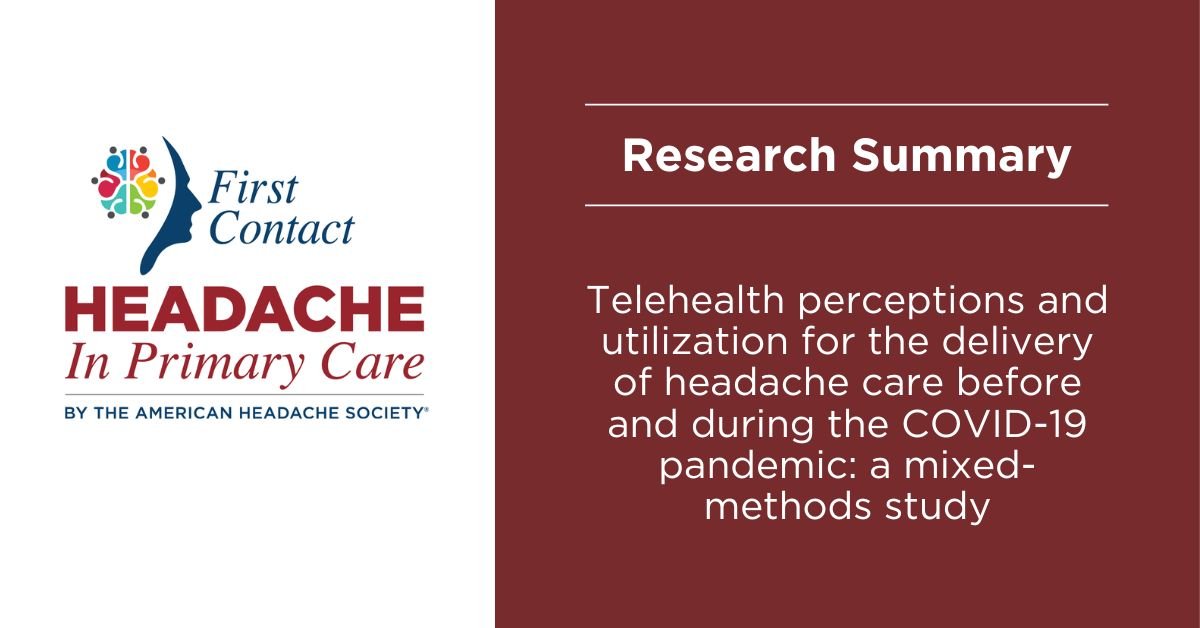
Research Summary: Telehealth perceptions and utilization for the delivery of headache care before and during the COVID-19 pandemic: a mixed-methods study
Summarized by Anna Pace, MD
Innovations in healthcare can be of great benefit to patients when implemented correctly. The rise of telehealth delivery of headache-related care is one such innovation that happened largely in response to the COVID-19 pandemic. While telehealth is a promising concept with rapid uptake, technological barriers abound. In order to secure equitable access to telehealth for those in need, understanding patient preferences regarding in-person versus telehealth visits, as well as identifying patient groups who face barriers to access, must be prioritized.
This month, the First Contact – Headache in Primary Care team summarized Telehealth perceptions and utilization for the delivery of headache care before and during the COVID-19 pandemic: a mixed-methods study.
Study Overview
- Telehealth had been gaining popularity even before the COVID-19 pandemic and has been associated with higher patient satisfaction, as well as increased access to specialty care.
- The pandemic lead to rapid expansion of telehealth but was accompanied by technological challenges.
- This study aimed to examine telehealth utilization across VA facilities and elucidate patient and provider perceptions of telehealth for headache care before and during the COVID-19 pandemic.
Study Methods
- Investigators analyzed data from 58,798 patients treated for headache in 12 VHA facilities (including a Headache Center of Excellence).
- Outpatient visit types were classified as in-person, VA Video Connect (VVC), Clinical Video Telehealth (CVT), and telephone.
- Semi-structured, open-ended interviews were conducted with 20 patients and 43 clinical providers pre-pandemic and 10 patients and 20 clinical providers during the pandemic.
Study Results
- Three-quarters of the patients were men with a mean age of 49.6 years; over half were white, and 22.4% were black; the majority lived in urban areas (80.7%).
- Patterns of Telehealth Utilization:
- Before the pandemic, almost all care occurred in person (98.6%); the number of patients using video CVT was low (1.6%).
- During the pandemic, the number of VVC appointments increased by 105%, and telephone visit volume was 15 times higher than that of pre-pandemic.
- In-person visits were still the most common visit type during the pandemic.
- Disparities in Telehealth Utilization During the Pandemic:
- Patients under 64 years of age had significant decreases in in-person appointments; those 65 years of age and up had more in-person appointments.
- Older patients were more likely to have telephone appointments.
- Black patients had a 52% reduction in monthly CVT visits but an 8.5% increase in telephone utilization, and they were less likely to utilize in-person and CVT visits compared to white patients.
- Hispanic patients were more likely to have VVC appointments and less likely to have in-person appointments compared to white patients.
- Rural-dwelling patients were more likely to use CVT appointments compared with urban-dwelling patients.
- Qualitative Data Pre-pandemic:
- Patients found telehealth appealing because they could attend appointments without disruption to daily responsibilities while also avoiding long travel times.
- Telehealth was especially appealing for those with physical limitations and who felt attending in-person appointments triggered headache attacks.
- Providers deemed telehealth appropriate for monitoring and adjusting pharmacotherapy and reviewing side effects of medications, as well as for behavioral treatments.
- Providers felt telehealth was beneficial for patients in rural areas or with rare headache disorders who have limited access to specialists.
- Qualitative Data During Pandemic:
- Some patients still preferred the familiarity of in-person visits, while others found telehealth was comparable to or more efficient than in-person care.
- Patients cited reduced need to travel, reduced travel stress, less disruption to daily schedule, and no additional trigger exposure as benefits of telehealth.
- Most patients younger than age 65 reported positive experiences with and preference for telehealth, whereas most patients over age 65 reported negative perceptions (e.g. missing interpersonal connections).
- Most women viewed telehealth favorably; men had mixed opinions – some were glad to avoid a long drive for care, others were concerned about technological challenges.
- Patients in rural areas more frequently reported technology and connectivity challenges compared with those in urban settings.
- Providers continued to praise increased ability to expand access to care.
- Many providers preferred in-person appointments for initial evaluations and favored telehealth for follow-up care.
Implications for Primary Care Clinicians
- There was a rapid uptake of telehealth headache care in the first six months of the pandemic.
- Telehealth for headache care appears to be highly acceptable to both patients and providers.
- These findings support a hybrid approach to headache care delivery.
- To facilitate more equitable access to telehealth, it is crucial to identify patient groups who face barriers, understand patients’ values, and foster optimal implementation of telehealth.
This summary is part of the First Contact — Headache in Primary Care initiative, an American Headache Society program that provides educational resources to empower healthcare professionals and improve headache and migraine care. We encourage providers in all stages of their careers to visit our homepage to access educational tools to improve patient care.


